
Originally published 11/1/21; updated 7/24/23
Basements can be challenging for homeowners. Even when they’re clean, dry, and well-lit, basements can still feel damp. This isn’t because you’re a bad housekeeper; it’s a side effect that comes with being partially underground. If the ground outside your basement is wet, your basement is going to have high humidity, which makes you feel damp.
This happens because concrete is a porous material; it allows water in the ground to seep into — and through — the foundation into the basement. This water intrusion can damage your foundation and take your basement from damp to wet.
Can a little basement humidity really be that much of a problem? Absolutely! We’re a family-owned and operated company that specializes in both foundation repair and waterproofing. We know how hydrostatic pressure works, how it allows water to infiltrate your basement, and why it’s so damaging to your home.
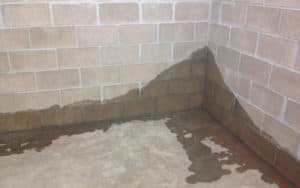 This photo was taken by an Acculevel project advisor during an in-home assessment. Water is seeping through the basement wall.
This photo was taken by an Acculevel project advisor during an in-home assessment. Water is seeping through the basement wall.
Since our start in 1996, Acculevel has helped more than 35,000 homeowners protect their homes from water damage and preserve the value of their greatest investment.
In this article, we’re going to explain the importance of a high-capacity dehumidifier for you and your house. You can gain better health, lower utility costs, and prevent expensive home repairs.
A dehumidifier is an appliance that reduces excess moisture by filtering and cooling the air. Basement dehumidifiers — or what we call whole-home dehumidifiers — are units designed to maintain the desired humidity level of your entire house.
Many homeowners use portable dehumidifiers during the summer to counteract the mugginess of warm weather. But these aren’t designed to manage large spaces or the excessive moisture that accompanies summer thunderstorms in the Midwest. Anyone who’s ever tried to keep up with emptying a portable dehumidifier — one bucket at a time — is aware of their limitations (not to mention the inconvenience).
The best basement dehumidifier will do more than counteract damp air; it will also have a direct impact on your quality of life.
Let’s take a look at some of the key benefits of having a basement dehumidifier.
Many small organisms have simple and easily-met needs for growth. A little moisture and a food source (like dust, pet dander, etc) are all that’s needed for unwelcome visitors like mold spores to flourish.
This is a serious problem for people with allergies or respiratory problems. Mold, mildew, and fungus are all very common allergens, and they can cause a range of unpleasant side effects. The most common ones are:
Indoor air quality is critical for children, especially infants, as they are susceptible to the effects of long-term mold exposure. Even healthy people who don’t have any known allergies can develop a sensitivity to mold spores, given enough exposure.
 This photo was taken by an Acculevel project advisor during an in-home appointment. You can see the small dots of black mold that cover this basement wall.
This photo was taken by an Acculevel project advisor during an in-home appointment. You can see the small dots of black mold that cover this basement wall.
A dehumidifier that regulates the humidity levels in your home will restrict a component that encourages mildew and mold growth.
[box type="info"] If mold affects an area of 10 square feet or more, the Environmental Protection Agency recommends that you consult a professional. You can learn more here.[/box]
Consistent dehumidifier usage doesn’t just inhibit the growth of mold and mildew. There are other organisms that also enjoy the high humidity levels found in basements. Some of these are a very clear and direct threat to your health.
A study published by the American Society of Heating, Refrigerating and Air-Conditioning Engineers (ASHRAE) demonstrated that the ideal humidity level in a house is around 50%. This is the most prohibitive level for microbes like bacteria, viruses, and other pathogens.
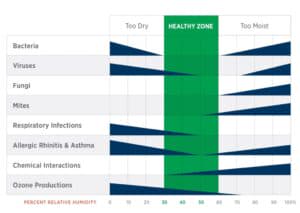 This chart was developed as part of ASHRAE's study.
This chart was developed as part of ASHRAE's study.
Simply put, if you regulate the relative humidity levels throughout your house, you'll have healthier air to breathe. This one action could significantly reduce the presence and survival of germs, which translates into fewer sick days and better overall health.
If you don’t have a dehumidifier, your HVAC has to compensate by drying the air, as well as cooling/heating it. Excessive moisture in the air is harder to process, which makes your air conditioning work harder.
Residents in hot dry climates are infamous for saying, “It’s not the heat, it’s the humidity,” when tourists complain about the temperature. While this isn’t always true — 90° and above is hot no matter what — humid air does make the heat feel worse. The damp and muggy sensation adds to the overall sensation of being too hot.
This means that damp air in your home will make you feel uncomfortable even when your home is at the preset (ideal) temperature you’ve chosen. This is often what causes homeowners to run fans in addition to the A/C or set their A/C to increasingly lower temperatures.
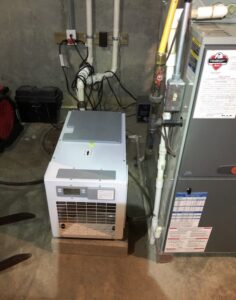 This photo was taken by an Acculevel crew member after installing a large-capacity dehumidifier in a customer’s basement next to the HVAC system.
This photo was taken by an Acculevel crew member after installing a large-capacity dehumidifier in a customer’s basement next to the HVAC system.
Both of those options use more energy, increasing your bills. And if you opt for the lower thermostat setting, your HVAC will have to run longer and more often. This also adds to your energy usage while also increasing the wear and tear on the HVAC equipment.
With a high-performing dehumidifier, your HVAC will run more easily and efficiently. If your humidity is being regulated, you may even be able to set the thermostat at a higher temperature and still feel comfortable. This allows your HVAC to function properly, doing what it’s designed to do, and extends the life of the appliance.
Unfortunately, a damp basement does more than breed biological growth and makes you uncomfortable. It also threatens the durability of the lumber used to build your home. Underneath the tile, carpet, or hardwood floor of your home is a subfloor and supporting structure. All of this is built out of wooden parts, and damp wood softens and decays over time.
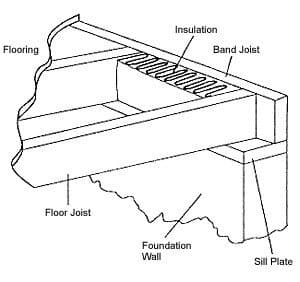 This diagram (courtesy of NCSU) shows you the various wooden components of your flooring structure.
This diagram (courtesy of NCSU) shows you the various wooden components of your flooring structure.
There are several ways to determine if the excess moisture in your basement is developing into structural problems.
The number one cause of sagging or sloping floors is a wet basement or crawl space. Significant creaking or the feeling of “give” or “softness” of the floor is another bad sign.
Essentially, what happens is excess moisture gets absorbed by the wood. This makes it softer, and softer wood is more likely to compress and flatten. This means your now softer flooring components are trying to hold firm while being loaded down with cabinets, furniture, appliances, etc. Eventually, the weight of your furnishings causes compression, which you notice as sagging floors.
 This photo was taken by an Acculevel project advisor during a home evaluation. You can clearly see the decay in the flooring structure.
This photo was taken by an Acculevel project advisor during a home evaluation. You can clearly see the decay in the flooring structure.
You’ll need a good foundation repair company like Acculevel to make repairs to the sill plate, floor joists, or whichever components have been damaged by moisture. Once the defective pieces are repaired or replaced, then you need to address the source of the moisture.
Another major concern is insects like termites. Much like mold, they don’t need much to thrive. They particularly like damp basements because when the wood is softened and easier to tunnel into.

This is an up-close look at termite damage on wood. (Photo courtesy of Angi’s List)
If you have termites or other wood-boring insects, you’ll need to start your repairs with an extermination service. This isn’t one of the services Acculevel offers, but we have an article that provides resources for finding a reputable service here.
A dehumidifier is an excellent household appliance, but it’s designed for mitigating a damp basement, not a wet basement.
If you have actual water seeping into the basement, you’ll need more significant repair options, like interior waterproofing.
Acculevel offers multiple types of water drainage track, superior sump pumps with battery backup, and premium encapsulation materials. (If you have a finished basement, or want to convert a portion of your basement into living space, encapsulation is a must!)
You can access our comprehensive basement waterproofing guide for free. This detailed resource was developed to address the questions we often receive from homeowners.
When you’re talking about moisture damaging a home’s foundation, you’re almost always discussing hydrostatic pressure. When there is more water in the soil than the ground can absorb, the excess water exerts pressure on your foundation.
You might be wondering, why does the water have to push on the house? It’s kind of like the water is trapped; it keeps flowing because the soil is fully saturated and can’t stop it. But when excess water reaches your foundation, it finds and fills the tiny gaps in the concrete. Essentially, the excess water will go anywhere it can find room for it.
But water can be seeping into your foundation for a while before you actually see it. Poured concrete walls are dense; it takes time for water to make it all the way through into your basement. Cinder blocks have hollow centers, so water that seeps in can collect inside and pool in place. By the time water is getting into your basement, your concrete wall is holding a significant amount of water.
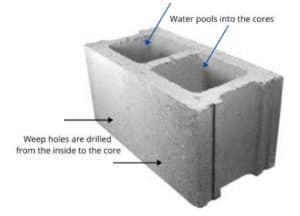
This illustration was created by the author.
If you have that much water getting into your home, a dehumidifier alone isn’t going to be enough. You’ll need waterproofing installed, which will include water drainage and a sump pump system. Weep holes will also be drilled into the bottom row of blocks to empty the water out of the blocks’ cores.
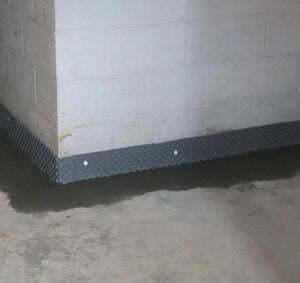 This photo was taken by an Acculevel crew member after installing water drainage in a customer’s home. The wet-looking concrete is the new concrete we poured over the installed drainage system; the weep holes are covered by the dimple board that will direct any water from the blocks into the drainage
This photo was taken by an Acculevel crew member after installing water drainage in a customer’s home. The wet-looking concrete is the new concrete we poured over the installed drainage system; the weep holes are covered by the dimple board that will direct any water from the blocks into the drainage
If the pressure is strong enough, it can sometimes create fissures or cracks in the walls. These cracks often allow water to come through, although this doesn’t happen all the time. Don’t make the mistake of dismissing a crack in your foundation just because it’s still dry. As we described above, the water may be inside the wall, not yet through the wall.
Long horizontal cracks or zig-zag style cracks are both signs that the stability of your basement wall is compromised. Don’t wait until the wall starts actively bowing or leaning inward to contact a pro; take action as soon as you see it happening.
 This photo was taken by an Acculevel project advisor during an in-home estimate. It illustrates both horizontal and zig-zag cracks.
This photo was taken by an Acculevel project advisor during an in-home estimate. It illustrates both horizontal and zig-zag cracks.
If you see these kinds of cracks in your basement or water getting inside, you should take prompt action. The sooner you have a problem diagnosed and repaired, the less expensive the repairs will be. Fixing a more extreme problem will be more invasive to your property and to your wallet.
We recognize that a whole-home dehumidifier costs more than a small portable version. But we also know that the benefits it will provide to you, your home, and your health are much greater as well.
A whole-home basement dehumidifier is more expensive to buy than a portable one, but it is less expensive to operate. Because it is designed to remove humidity from your entire home, it will operate efficiently, then shut off when it isn’t needed. The unit Acculevel installs can remove up to 12 gallons in a single day and is designed to cover up to 5,200 square feet.
A portable unit is only designed to remove humidity from a single room or small living space. But air doesn’t stay in one room, right? It moves around, from room to room and level to level. So a portable dehumidifier just keeps drying air and runs non-stop until you turn it off. Most can only remove 50 pints (or less) per day and aren’t meant to cover more than 500 square feet.
A high-capacity dehumidifier should be programmable, allowing you to select your desired humidity level. As the ASHRAE study indicated, the ideal humidity level is right around 50%. You may discover that setting works fine for you in the summer, but in the winter you need 45% or 55% for your ideal comfort.
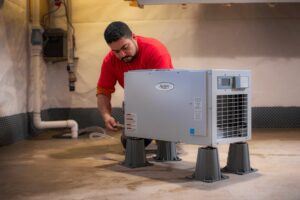 This is a photo of an Acculevel crew member, installing a dehumidifier in an encapsulated basement. You can see the drain hose is routed to the sump pit.
This is a photo of an Acculevel crew member, installing a dehumidifier in an encapsulated basement. You can see the drain hose is routed to the sump pit.
As the humidity is pulled from the air, it condenses into water. Portable dehumidifiers store this collected moisture in a tank that needs to be emptied regularly; when the tank is full, the dehumidifier stops running until the tank is drained.
The best basement dehumidifiers don’t use a tank. The condensation is instead routed via a drainage hose directly into your sump pump or basement floor drain. This continuous drainage line means you don’t have to worry about tank levels, lugging a full water bucket to a utility sink or bathroom, or about it shutting off when you need it most.
Portable dehumidifiers are designed for use in warm weather because this is when the air humidity is at its highest. But humidity doesn’t miraculously evaporate in the other seasons of the year; humidity can remain year-round in underground spaces like basements or crawl spaces. This is because the soil around your foundation holds moisture far better than the open air above ground. Moisture kept in the ground can then seep into the concrete of your basement walls.
In fact, the dramatic difference in temperature can make humidity a significant issue in the winter months. The contrast between the cold temperatures outside and the much warmer indoor air generates condensation that often goes unaddressed.
Whole-home dehumidifiers are designed to be installed in basements or crawl spaces. They’ve been manufactured to function in areas of your home that get colder than your living spaces. Removing this moisture from your foundation improves the health and stability of your foundation.
The standard manufacturer’s warranty for a portable dehumidifier is one year. If you add up the costs to buy 5 or more portable units over a 5 years span, the difference in cost drops significantly. Safety is another potential concern. Many dehumidifiers have been subject to product recalls over the past 10 years.
Aprilaire estimates the average lifespan of their whole-home dehumidifier is 15 years (their manufacturer’s warranty is 5 years). They are Energy Star certified, and the model Acculevel installs received the 2022 award for being the most energy efficient on the market. The 100-pint dehumidifier is one of the largest capacity models they make.
Are you worried about the musty smell in your basement, potential mold growth, or frustrated by the damp clamminess in your basement? Then it’s time to improve your indoor air quality and overall home health!
If you live in Indiana or the surrounding areas, call Acculevel at 866-669-3349. We’ll make an appointment for you with one of our friendly and knowledgeable project advisors. They will meet with you, evaluate your entire home, and address your concerns.
Our goal is to provide you with a whole-home solution, resolving the current problem you have, and helping you to prevent or avoid future issues as well. If you prefer electronic communications, you’re welcome to complete our online form instead!
[DISPLAY_ULTIMATE_SOCIAL_ICONS]